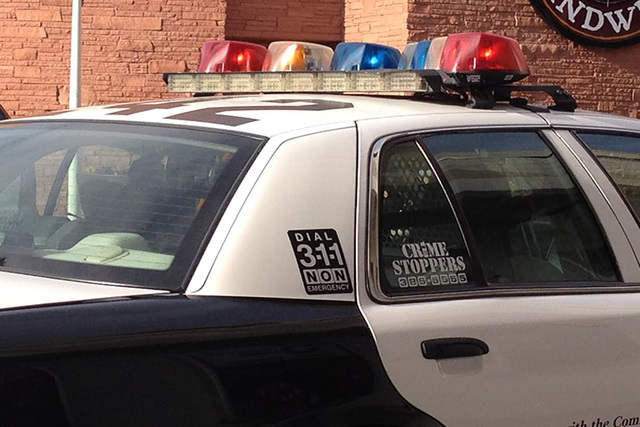Metro says officers facing more danger
Policing Las Vegas has never been easy.
But 2014 has been a particularly violent year for police. The Metropolitan Police Department has seen a spike in officer-involved shootings across the valley.
A reason for the increase, police say, is that the situations that police respond to are more likely to turn violent.
“We’ve seen an unprecedented amount of suspects shoot at our officers this year, or shoot our officers,” Las Vegas police Sgt. John Sheahan said.
Metro has been involved in 11 officer-involved shootings so far this year, compared to seven in the same time frame last year. North Las Vegas has had two, and Henderson one. Both agencies had one apiece in 2013.
Most of those shootings, according to police, started as a routine call that escalated quickly after their officers arrived.
The most notable police shooting of this year, Jerad and Amanda Miller’s June ambush that killed Metro officers Alyn Beck and Igor Soldo, occurred while the two officers were taking their lunch break at a Las Vegas pizza restaurant. Jerad Miller died from returned police gunfire at a Wal-Mart where the couple holed up, and his wife Amanda died after shooting herself.
But circumstances of a more recent shooting showed just how quickly a routine traffic stop can turn deadly. On Friday, North Las Vegas police tried to pull over a man riding a moped. The man fled and eventually pulled out a replica gun, prompting officers to shoot and kill him, police said.
In all 14 police shootings this year, everyone officers shot had weapons. In three, suspects fired directly at officers.
People in Las Vegas have been more prone to let a small situation turn into a big one this year.
“It goes from zero to high-order violence,” Sheahan said.
Assault and battery statistics this year have kept pace with 2013, but the severity has gone up, Sheahan said.
Last year saw a serious spike in domestic violence calls that turned into homicides. Those numbers have been lower this year, but other areas are worrisome.
The officer-involved shootings have escalated, and barricade situations with the SWAT unit have become a matter of concern to officers and negotiators. Fewer confrontations are ending peacefully, Sheahan said.
Demographic trends don’t link the violent situations, Sheahan said.
The connection, he said, appears to be a distaste for government. And who is the most visible and easily-accessible form of government?
Sheahan answered his own question with another one about the June slaying of officers Beck and Soldo and Wal-Mart shopper Joseph Wilcox: “Who would it be easy for the Millers to take it out on?”
Targeting law enforcement isn’t just a Las Vegas problem; it’s a national one, police say.
So far, 28 police officers have been killed by firearms throughout the United States in 2014, a 65 percent increase over the 17 from the same point last year, according to statistics from the National Law Enforcement Officers Memorial Fund.
But at least one expert says the numbers don’t necessarily reflect an increase in violent behavior toward law enforcement nationally.
“These things happen, and sometimes they happen in clusters,” said David Klinger, a criminal justice professor at the University of Missouri-St. Louis and a former Los Angeles police officer.
Last year was a historically low year for officer shooting deaths, with 31 nationally.
Eventually, Klinger said, the numbers were “going to bump back up.”
“The numbers are still far lower than they were in the 1970s,” he said.
Nearly 140 officers died by gunfire each year during the early part of that decade.
National Law Enforcement Officers Memorial Fund data only records causes of death, according to Klinger, which isn’t complete enough to compare generations.
He said improved trauma care and more prominent use of Kevlar body armor by officers have helped bring the total number of officer fatalities down.
The numbers don’t accurately measure whether officers are facing more or less danger than in years past, Klinger said. “Unfortunately we don’t have really good data on officer shootings.”
A career in law enforcement poses a much higher risk now than it used to, Clark County Sheriff Doug Gillespie said in an interview Thursday.
Gillespie said he knows his officers are being asked tough questions at home by nervous family members about the danger of the job.
But it wasn’t always this way, Sheahan said
“The gun was used more for intimidation than it was ever going to be used to shoot somebody,” he said, recalling his time as a patrol officer 20 years ago.
It’s a drastically different environment now.
“It’s not the community I was protecting a quarter-century ago,” he said.
Contact reporter Annalise Little at alittle@reviewjournal.com or 702-383-0381. Find her on Twitter:@annaliselittle_ . Contact reporter Colton Lochhead at clochhead@reviewjournal.com or 702-383-4638. Find him on Twitter: @ColtonLochhead.

















